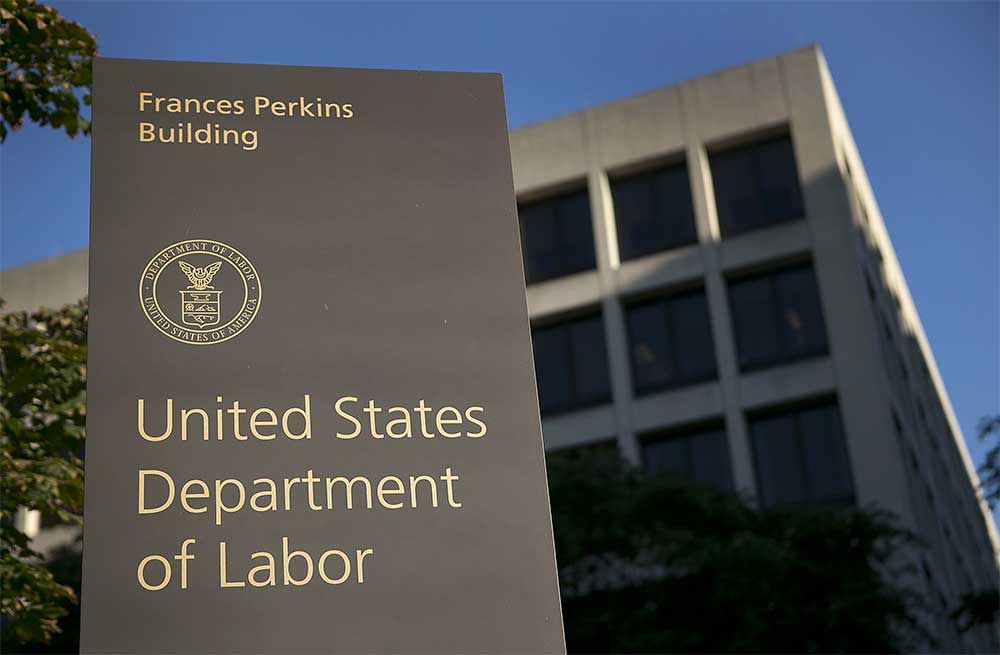
WASHINGTON—A rule released by the federal Department of Labor Jan. 12 will narrow when companies can be considered “joint employers,” making it harder for them to be held responsible for wages or working conditions at their franchises or contractors.
The rule, which will go into effect March 16, is intended to reverse a 2015 decision by the National Labor Relations Board that ordered Browning-Ferris Industries to bargain with a Teamsters local that had organized workers at its recycling plant near San Jose, even though BFI hired them through a staffing agency. BFI, the board said, exercised enough indirect control—setting maximum wages, staffing levels, and production goals for workers hired through the agency—to be considered a joint employer.
The new rule replaces that with a “four-factor balancing test.” That test, according to the Labor Department, examines whether the potential joint employer hires or fires the employee; supervises and controls their work schedule or conditions of employment to a substantial degree; determines their rate and method of payment; and maintains employment records. The department said the rule “specifies that an employer’s franchisor, brand and supply, or similar business model and certain contractual agreements or business practices” do not make joint-employer status more or less likely.
“The changes in this final rule break down barriers that keep companies from constructively overseeing, guiding, and helping their business partners,” department Wage and Hour Division Administrator Cheryl Stanton said in a statement. “For small business owners, and the employees working in those businesses, the relationship and the guidance coming from franchisors and other contracting companies can greatly improve the workplace and help them create jobs.”
The International Franchise Association called the rule “a major victory for America’s franchise businesses.” “Through this rulemaking, the DOL has successfully undone one of the nation’s most harmful economic regulations,” it added. The trade group cited a January 2019 study it commissioned by Chamber of Commerce economist Ronald E. Bird that said the NLRB’s Browning-Ferris decision “has cost the franchising sector as much as $33.3 billion annually and has resulted in as many as 376,000 lost job opportunities.”
Bird blamed the expanded joint-employer rule and “the SEIU campaign against fast-food franchises” for nearly doubling the number of joint-employer petitions filed with the NLRB against franchise businesses, from 122 between 2010 and 2014 to 236 during the next four years.
“The Trump Administration has once again rigged the rules in favor of corporations against working people,” National Employment Law Project executive director Rebecca Dixon responded. She said the revised joint-employer standard “makes it easier for corporations to cheat their workers and look the other way when workplace violations occur” and “dramatically and improperly narrows companies’ joint responsibility for respecting fair pay and child labor laws, exposing millions of workers to wage theft.”
The rule specifies that a company cannot be considered a joint employer simply because it has the contractual power to control workers employed by another party; there has to be “some actual exercise of control.” Labor unions including the AFL-CIO and SEIU strongly opposed that change. The new rule states that a contractor or franchisee having followed a request or recommendation to fire a worker or set pay rates is not enough to demonstrate indirect control, “but can be indicative in rare circumstances.”
The Labor Department also said that contracts requiring quantity or quality-control standards or “the use of standardized products, services, or advertising to maintain brand standards” do not make joint-employer status more or less likely. Neither do practices such as a company providing the direct employer a sample employee handbook, or offering an association health-insurance or retirement plan.
The department admitted that the rule might result in a transfer of wealth from workers to employers, because “employees will have the legal right to collect wages due… from fewer employers.”
“This rule creates an incentive for large corporations to outsource work to staffing companies or subcontractors and escape responsibility,” Heidi Shierholz and Margaret Poydock of the Economic Policy Institute said in a statement Jan. 13.
The Fair Labor Standards Act of 1938, they added, was written to ensure that “companies that use staffing companies or subcontractors in their business operations are held accountable for complying with basic workplace protections.” The new rule “substantially limits shared liability for wage and hour violations, making it harder for workers to hold all parties who set their terms of employment accountable.”
An EPI study submitted to the department during the public-comment period last June estimated that the rule would cost workers more than $1 billion a year: more than $950 million in lower wages paid to workers who aren’t direct employees, and more than $138 million from increased wage theft.
“When a company ‘calls the shots’ in a workplace, that company should be accountable for how the workers there are treated—no matter what the company calls the workers or how it classifies them. So when a company decides to contract out work to a temp or staffing firm or other labor subcontractor, it should share responsibility for the workers,” Dixon said. “Too many employers use temp agencies and subcontractors to try to duck responsibility for wage theft.”

